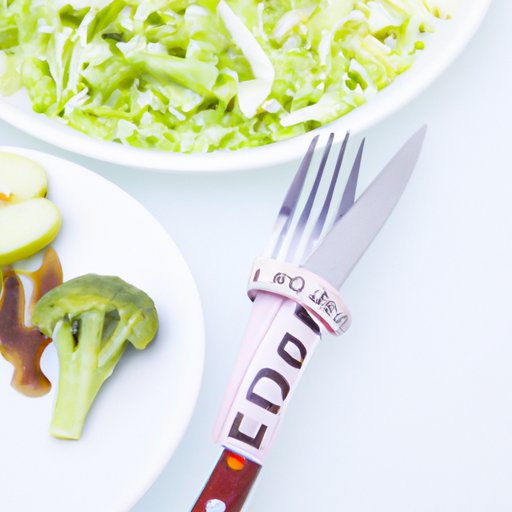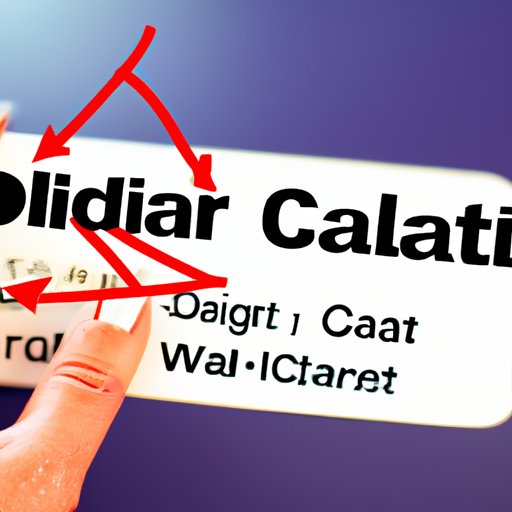Introduction
When it comes to losing weight, understanding your caloric needs is essential. Knowing how many calories you should eat each day will help you create an effective diet plan that will help you reach your weight loss goals. In this article, we’ll explore the importance of understanding your caloric needs for weight loss, how to calculate them, and how to create a calorie deficit to reach your goals.
Calculating Your Caloric Needs for Weight Loss
The first step in understanding your caloric needs for weight loss is calculating your basal metabolic rate (BMR). BMR is the number of calories your body needs to function while at rest. To calculate your BMR, use the Harris-Benedict equation:
For men: BMR = 66 + (6.2 x weight in pounds) + (12.7 x height in inches) – (6.76 x age in years)
For women: BMR = 655.1 + (4.35 x weight in pounds) + (4.7 x height in inches) – (4.7 x age in years)
Once you have calculated your BMR, you can then calculate your total daily energy expenditure (TDEE). TDEE is the number of calories your body needs to maintain its current weight. To calculate your TDEE, multiply your BMR by an activity factor to account for the energy you expend throughout the day. The activity factors are as follows:
- Sedentary lifestyle (little or no exercise): BMR x 1.2
- Lightly active lifestyle (light exercise/sports 1-3 days/week): BMR x 1.375
- Moderately active lifestyle (moderate exercise/sports 3-5 days/week): BMR x 1.55
- Very active lifestyle (hard exercise/sports 6-7 days a week): BMR x 1.725
- Extra active lifestyle (very hard exercise/sports & physical job or 2x training): BMR x 1.9

Understanding the Role of Calories in Weight Loss
Once you know your BMR and TDEE, you can begin to understand the role of calories in weight loss. Calories come from three macronutrients – carbohydrates, proteins, and fats – and several micronutrients such as vitamins and minerals. It’s important to understand the role of each of these nutrients in your diet and how they contribute to weight loss.
Carbohydrates provide the body with energy and are broken down into glucose, which is used by the body for fuel. Protein is essential for building muscle and repairing tissue, and fats are necessary for hormone production and other bodily functions. Micronutrients are also important for maintaining overall health and wellbeing.
In order to lose weight, you need to create a calorie deficit. This means that you need to consume fewer calories than your body needs in order to lose weight. This can be done by reducing your caloric intake or increasing your activity level.
Finding the Right Balance of Calories to Lose Weight
Now that you understand the role of calories in weight loss, you can begin to find the right balance of calories to lose weight. The best way to do this is to establish a healthy calorie intake and determine the right balance of macronutrients.
A healthy calorie intake is based on your individual needs, taking into account your age, gender, body size, activity level, and weight loss goals. Most health professionals recommend aiming for a calorie deficit of 500-1000 calories per day for safe and sustainable weight loss.
It’s also important to find the right balance of macronutrients. Aim for a diet that is rich in protein, low in carbohydrates, and moderate in healthy fats. For example, a diet that contains 40% carbohydrates, 30% proteins, and 30% fats is considered a balanced diet.

Eating Healthy and Cutting Calories to Lose Weight
Once you’ve established a healthy calorie intake and determined the right balance of macronutrients, you can begin to make smart swaps to reduce calories. Choose foods that are lower in calories but still provide essential nutrients. Some examples of healthy, low-calorie foods include fruits and vegetables, lean proteins, whole grains, nuts and seeds, and healthy fats. These foods are packed with essential vitamins and minerals, making them an excellent choice for those looking to lose weight.
You can also make smart swaps to reduce calories. For example, instead of sugary snacks like candy and cookies, opt for healthier alternatives like fruit and yogurt. Instead of white bread and pasta, choose whole grain options. And instead of high-calorie drinks like soda and juice, opt for water or unsweetened tea and coffee. Making small changes like these can add up to big results when it comes to weight loss.

Creating a Calorie Deficit to Reach Your Weight Loss Goals
Creating a calorie deficit is the key to reaching your weight loss goals. There are several strategies you can use to create a calorie deficit. For example, if you want to lose one pound per week, you need to create a calorie deficit of 500 calories per day. You can do this by reducing your caloric intake, increasing your activity level, or a combination of both.
You can also use the following strategies to create a calorie deficit:
- Eat smaller portions and cut back on processed foods.
- Drink more water and limit sugary beverages.
- Eat plenty of fiber-rich foods to keep you feeling full longer.
- Incorporate strength training into your workouts to build muscle and burn fat.
- Get enough sleep to ensure your body is adequately rested.
Conclusion
Understanding your caloric needs is key when trying to lose weight. Calculating your BMR and TDEE will help you understand how many calories you need to reach your goals. Eating healthy and creating a calorie deficit are essential for successful weight loss. By eating the right foods, cutting calories, and creating a calorie deficit, you can reach your weight loss goals.
(Note: Is this article not meeting your expectations? Do you have knowledge or insights to share? Unlock new opportunities and expand your reach by joining our authors team. Click Registration to join us and share your expertise with our readers.)
